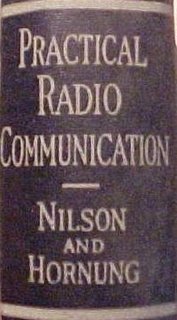 One of the first steps taken by the Department of Commerce was to divide terrestrial radio licences into 8 classes:
One of the first steps taken by the Department of Commerce was to divide terrestrial radio licences into 8 classes:1-Public Service
2-Limited Commercial
3-Experimental
4-Technical and Training School
5-General Amateur
6-Special Amateur
7-Restricted Amateur
8-High Power
In the this era of broadcasting transmissions were mostly sent by shore stations that operated under Public Service licences. The rest were largely Government stations, broadcasting weather and time signals and the rest was just experimental. It was only later that the vast improvement in audio transmitters led to an expansion in the number of licence classes.
The largest number held Experimental licences, including famous stations like 1XE in Medford Hillside, MA, 8XB in Cincinnati, OH, and Frank Conrad's 8XK in Pittsburgh, PA (it became KDKA) . The government stations, included AGI, operated by the Army Signal Corps in San Francisco, WWV, operated by the Bureau of Standards in DC, and the Navy's NOF, and NSF, located in Anacostia, D.C. which I've written about before Here.
Modifications began immediately in earnest and in 1913 the the High Power class was dropped, and its stations absorbed into the other categories. At the time the threshhold of "high power" was constantly rising and quickly became meaningless. One of the strange things about the 1912 regulations is that they made no refernece to broadcasting. Much like early wireless and telegraph communication over wire the ideas were still somewhat corralled under a point-to-point way of thinking. The first license released was for KDKA for Westinghouse on October 27, 1920. But even then, KDKA's original application, and its initial licence, contained no reference to broadcasting. In the beginngin the station was only intended to be used as one of a group of radiotelegraph stations providing point-to-point service between company facilities in various cities. It was not "broadcasting" as it were. It was only days later that the station's audio transmitter was used to broadcast. As you may know, it was to announce the election returns on November 2, 1920. For the first few days these broadcasts went out under a temporarily assigned call of 8ZZ, on 545 AM. Shortly afterwards, the broadcast service began sharing the Limited Commercial KDKA calls with the point-to-point operation which was on 1330 AM. (imagine sharing calls now?)
So there it was. History did not record how or who managed to sneak broadcasting in under the wire into licensed legitamacy out of the ameteur arena. But it was someone probably inside KDKA and probably with the collaboration of someone inside the commerce department...
Try to remember at the same time that the Bureau of Navigation was also still licensing staitons in their own totally different way...
Things were more orderly what I would call "less bad" but still not good. That didn't get hashed out intil 1921. But Broadcasting would not become a separate licence until radio regulation was transferred to the FRC (Federal Radio Commission) in 1927. more on how that went down tomorrow.




No comments:
Post a Comment